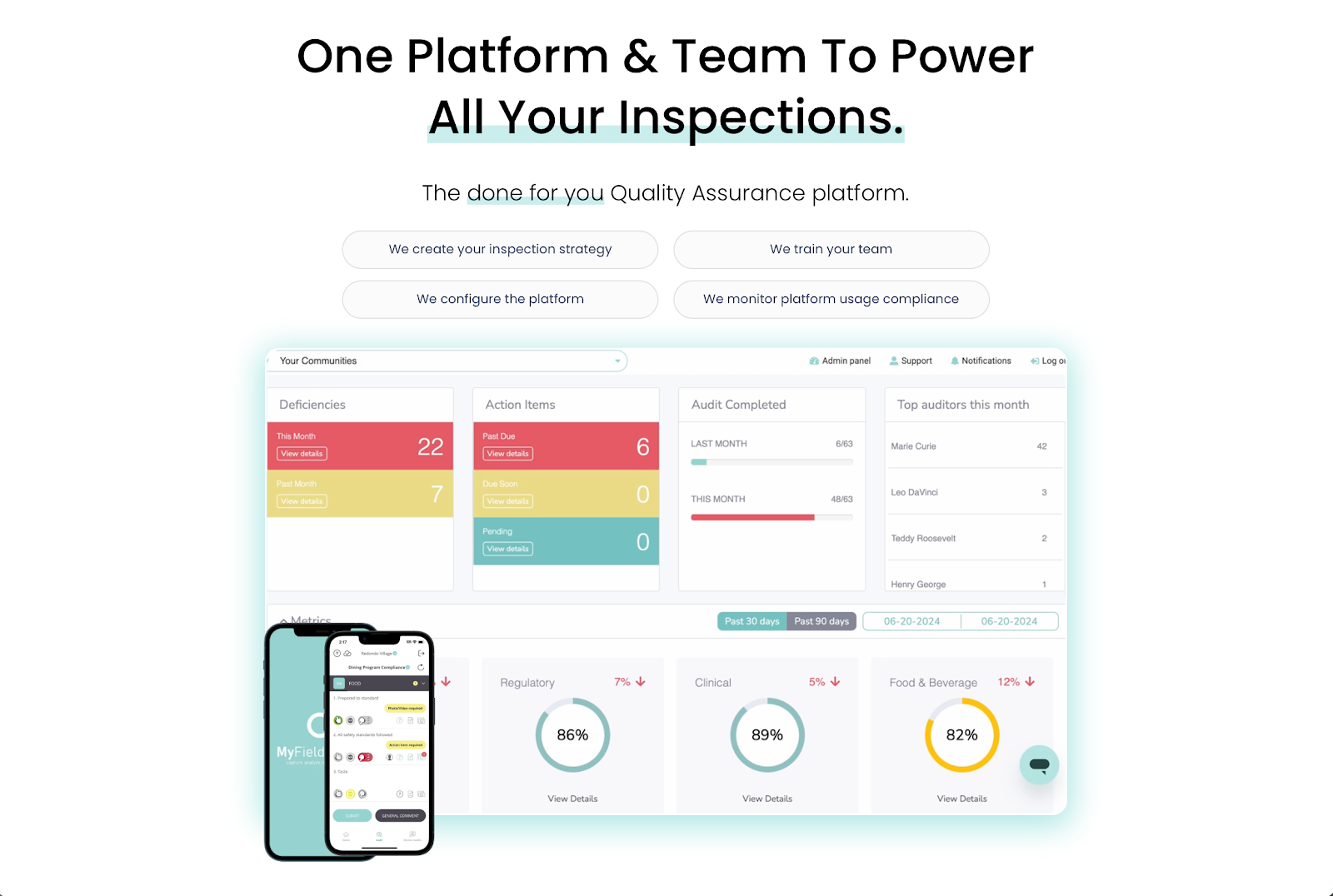.svg)
How to Prepare for a Restaurant Safety Inspection

Take Control of QA.
Make Inspections Effortless.

We’ll quickly uncover your needs and share how we can help—no pressure, no stress, just solutions. Grab your spot on our calendar today!
Every restaurant and food service management company will face safety inspections.
These inspections are not just a formality. They’re a direct reflection of your operational standards, staff training, and attention to food safety rules.
You need to prepare in advance to avoid violations and maintain your food establishment's good standing. This enables you to deliver what you promise and retain customers.
In this article, we will break down what to expect and how to get ready for restaurant safety inspections.
What Is a Restaurant Safety Inspection?
A restaurant safety inspection is a formal review of an establishment’s food handling, sanitation, and storage practices. It helps confirm that daily operations meet public health and quality control standards.
Responsible restaurant owners and food service management companies understand that it’s part of doing business. It helps you meet regulatory compliance, sustain operations, and maintain high standards even while you scale.
A routine inspection may happen once or twice a year. The exact frequency depends on your location, business size, and history.
Food safety inspectors rarely provide a date in advance. They often show up unannounced, so staying prepared at all times is important for food service teams.
Who Conducts Restaurant Safety Inspections?
Restaurant safety inspections are done by several parties.
- Local health departments: State health regulators, typically under the authority of the Food and Drug Administration (FDA), conduct food safety inspections. They check if restaurants meet local health codes and follow food and beverage regulations. After the inspection, they issue a restaurant's score rating or grade and follow up on customer complaints.
- Food safety agencies: Federal food safety agencies support local health inspections. They conduct checks for food safety practices in larger facilities or in response to major foodborne illness outbreaks. Common examples include the FDA, the Department of Agriculture's Food Safety and Inspection Service (USDA FSIS), and the Centers for Disease Control and Prevention (CDC).
- Third-party certification bodies: Restaurants or food service operators looking to obtain a food safety certification need to pass audits conducted by third-party accreditation bodies. These include the Global Food Safety Initiative (GFSI), the National Sanitation Foundation (NSF), and the International Organization for Standardization (ISO), among others.
What to Expect During a Restaurant Safety Inspection
Before preparing for a safety inspection, you need to know what to expect when inspectors arrive on site.
Provide an Overview of Your Facility
Once inspectors visit your restaurant, someone should be ready to greet them and explain the layout of your site. This includes showing the kitchen, storage, food prep areas, and even the restroom. Having large signs will help.
Walk with confidence and show that your team is following guidelines. This clear and organized start sets the tone for the entire visit.
Answer Questions About Food Handling and Safety Practices
You should also be ready to answer questions about your food standard operating procedures (SOPs) and food preparation practices.
Make sure your team has the knowledge to answer accurately and calmly. Food handlers should know how to avoid cross-contamination, maintain the proper temperature, and serve food with clean utensils.
Observe the Inspector’s Evaluation of Key Risk Areas
After asking basic questions, inspectors will start evaluating your food service establishment. They typically check these six key categories during the food safety inspection:
- Food storage: Inspectors check for proper separation of raw and cooked or ready-to-eat food. Storage containers must be properly labeled and dated. You should also keep items away from the floor or chemicals.
- Time and temperature control: The restaurant inspection process involves checking refrigeration, holding units, and cooking temperatures to make sure they meet food safety compliance. For example, raw meat shouldn't fall in the temperature danger zone (between 40°F and 140°F) and shouldn't be thawed in hot water to prevent foodborne illnesses.
- Cross-contamination: Inspectors will watch how food handlers use cutting boards, knives, and gloves. Using a single tool for raw meat and vegetables is a red flag because it can increase the risk of food contamination.
- Personal hygiene: Inspectors also observe if staff members wear clean uniforms, wash their hands often, and follow basic grooming rules. Employees should avoid bare-hand contact with food when gloves are required.
- Cleaning and sanitization: Food safety inspections involve checking how often surfaces are cleaned, if sanitizers are being used properly, and whether cleaning logs are maintained.
- Pest control measures: Inspectors will scan your restaurant site for evidence of pests, such as droppings, insects, or damaged packaging. They also check if trash areas and entry points are properly sealed.
Present Required Documentation for Review
Inspectors may ask for temperature logs, cleaning schedules, certifications, training records, and compliance history. Keep these documents in an accessible and secure location.
If something is missing, it’s better to admit it than scramble. Stick to facts and show that you're keeping up with what matters most.
Receive Feedback and Review the Inspection Report
At the end of the inspection, the official will share their findings. Listen carefully, ask questions, and take notes.
If you receive critical violations, ask for clear reasons and next steps. Understand what needs to be fixed and how soon.
The inspection report may also include deadlines for a follow-up inspection. Make sure to address food safety concerns, correct violations, and make informed choices in the future to avoid further penalties.
How to Prepare for a Restaurant Safety Inspection
Now that you know what to expect, let’s discuss how to get ready before the inspector shows up. Here are some tips to keep in mind:
1. Conduct a Mock Restaurant Safety Inspection
Run a mock safety inspection to address problems before the official inspection and help your employees feel confident.
Start by walking through your facility like an inspector would. Use a food safety checklist and take notes. Look at food storage, employee health and personal hygiene, sanitation practices, and documentation.
Better yet, use a restaurant inspection checklist app to replace paperwork with digital forms. This makes it easier to track issues, set reminders, and store notes for future reference.
2. Establish a Regular Cleaning and Maintenance Schedule
Routine cleaning should never wait until inspection day. Set a regular schedule for daily, weekly, and monthly tasks. Break it down by area, such as kitchens, floors, prep areas, storage, and restroom facilities.
Assign clear responsibilities and post schedules where staff members can see them. You can require signatures after each task is done.
Inspections will go smoothly when cleaning habits are part of your daily routine and not something done at the last minute.
3. Check for Proper Food Storage and Handling
Review your storage areas every week. Raw and cooked food should be clearly separated. Labels should include names and dates.
You can practice FIFO (first in, first out) to avoid spoilage. Check that all containers are sealed and stored off the floor in all circumstances.
Poor food storage is one of the most common violations, and fixing it is often simple with regular oversight.
4. Inspect Kitchen Equipment
Broken, dirty, or unsafe equipment can also lead to food safety violations.
Check all thermometers, refrigerators, freezers, ovens, and dishwashing machines. Make sure they work properly and are being cleaned regularly.
Keep repair records in a binder or digital file to make informed decisions. For example, if certain equipment is constantly under maintenance, consider replacing it right away.
5. Train Employees on Food Safety Protocols
Provide regular training sessions on handwashing, glove use, safe food handling, allergen awareness, and emergency procedures. These keep everyone on the same page and reduce miscommunication.
You can also place signs near hand sinks and prep stations as reminders.
Well-trained employees make inspections easier and safer for everyone. Plus, confident staff members show inspectors that you care about getting things right.
6. Organize All Required Documentation
Pull together all records that might be requested during an inspection. This includes employee training certificates, temperature logs, cleaning records, pest control reports, internal audit notes, and last inspection results, if applicable.
Store these documents in a central location and keep them updated. Digital tools or folders can help you stay organized and maintain operational viability.
When inspectors see that you have everything ready, they’re more likely to view your operation as professional and well-managed.
7. Invest in Food Safety Management Software
Managing food safety across multiple locations can be difficult without tools to keep everything organized.
Food safety management software allows you to schedule regular audits, track temperatures, monitor staff training, and store inspection records all in one place.
Some platforms also offer alerts for missed tasks or expiring certifications. These are especially helpful in multi-site management and keeping all locations consistent.
The best software vendors even provide professional support, from platform configuration to employee training. This allows you to focus on capturing critical data that drives continuous growth and operational viability.
Why Do You Need to Pass Restaurant Safety Inspections?
Here are the reasons why passing the inspection matters for any restaurant or food service company:
Ensure Regulatory Compliance
Following food safety regulations is required by law. Passing inspections shows your business is doing things the right way.
It also keeps the public safe and reduces legal implications like fines, penalties, and lawsuits. This means you can maintain financial stability, retain clients, and increase profitability.
Keep Customers Safe and Prevent Foodborne Illnesses
Improper handling of raw meat, seafood, poultry, or other high-risk items can lead to illness. Passing inspections means your business knows how to handle certain food safely every time.
Customers will remain safe and enjoy eating at your establishment. This can directly benefit your bottom line, as happier customers translate to increased loyalty and positive word of mouth.
Maintain Operational Licenses and Permits
Failing a food safety inspection could put your business license at risk. Clean records help protect your restaurant's ability to stay open and operate without interruption.
Protect Your Reputation
People care where their food comes from. If inspectors find dirty prep areas or spoiled food, customers might stop trusting your brand, especially when they see negative feedback or public reports online.
Stay Inspection-Ready With MyFieldAudits
MyFieldAudits helps food service operators prepare for food safety inspections through its mobile-friendly inspection platform.

Designed for enterprise clients, MyFieldAudits lets you conduct audits, create checklists, assign corrective actions, and capture photos and videos from one platform. These help you quickly address food safety violations and prove compliance when asked.
However, MyFieldAudits is more than just another digital inspection app. It acts as a retention engine that takes care of training, platform configuration, and compliance tracking for your food service establishment.
This allows you to focus on capturing important data that drives continuous improvement.
Request a demo today or watch this video to learn how MyFieldAudits can improve your inspection processes.
FAQs About Restaurant Safety Inspection
What is the most important thing that inspectors look for in a restaurant inspection?
Inspectors focus heavily on food storage and temperature control. They check if raw and cooked foods are separated, whether refrigeration and cooking temperatures stay out of the “danger zone,” and if food comes from approved sources.
They also look for facility cleanliness, employee hygiene, and pest control measures.
What are the five basic food safety rules?
The World Health Organization (WHO) outlines the five basic principles of food safety, which restaurants can follow.
- Keep hands, utensils, and surfaces clean.
- Separate raw and cooked food.
- Cook food thoroughly to kill bacteria.
- Store food at safe temperatures.
- Choose safe drinking water and raw materials.
What is the most common health violation in restaurants?
Many restaurants have improper food storage practices. Common violations include failing to separate raw and cooked food, storing items on the floor, and keeping containers unsealed or unlabeled.
These show that preventative practices were not determined or enforced well.
What are the seven steps of food safety?
Hazard Analysis Critical Control Point (HACCP) defines the seven important steps of food safety:
- Conduct a hazard analysis.
- Identify critical control points (CCPs).
- Establish critical limits.
- Monitor CCPs to ensure they are under control.
- Take corrective actions when limits are breached.
- Verify that your HACCP plan works.
- Maintain complete documentation and records.
%201.svg)






%201%20(1).svg)